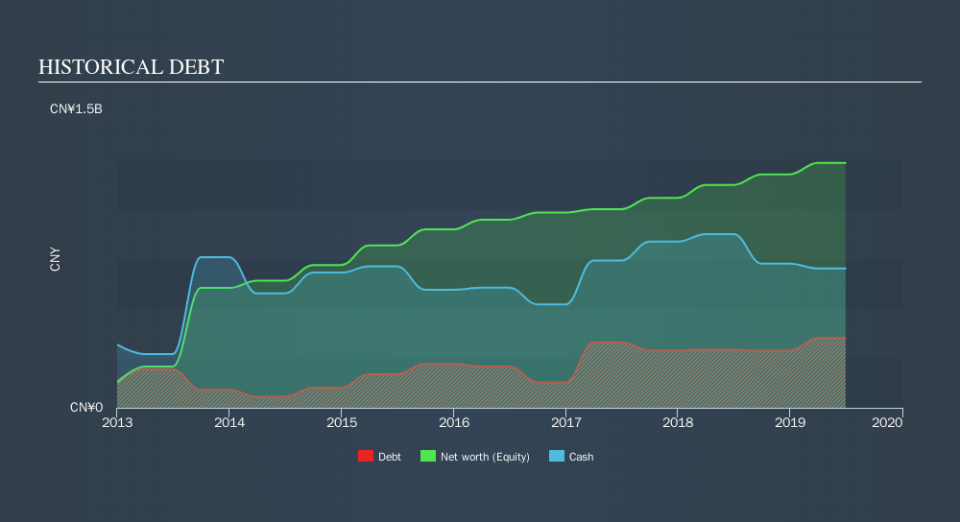Cabbeen Fashion (HKG:2030) Seems To Use Debt Quite Sensibly

Howard Marks put it nicely when he said that, rather than worrying about share price volatility, 'The possibility of permanent loss is the risk I worry about... and every practical investor I know worries about. It's only natural to consider a company's balance sheet when you examine how risky it is, since debt is often involved when a business collapses. We can see that Cabbeen Fashion Limited (HKG:2030) does use debt in its business. But should shareholders be worried about its use of debt?
When Is Debt A Problem?
Debt is a tool to help businesses grow, but if a business is incapable of paying off its lenders, then it exists at their mercy. If things get really bad, the lenders can take control of the business. However, a more usual (but still expensive) situation is where a company must dilute shareholders at a cheap share price simply to get debt under control. Of course, debt can be an important tool in businesses, particularly capital heavy businesses. The first thing to do when considering how much debt a business uses is to look at its cash and debt together.
View our latest analysis for Cabbeen Fashion
How Much Debt Does Cabbeen Fashion Carry?
As you can see below, at the end of June 2019, Cabbeen Fashion had CN¥351.0m of debt, up from CN¥292.4m a year ago. Click the image for more detail. But on the other hand it also has CN¥700.1m in cash, leading to a CN¥349.1m net cash position.
How Healthy Is Cabbeen Fashion's Balance Sheet?
Zooming in on the latest balance sheet data, we can see that Cabbeen Fashion had liabilities of CN¥779.7m due within 12 months and liabilities of CN¥6.17m due beyond that. On the other hand, it had cash of CN¥700.1m and CN¥447.3m worth of receivables due within a year. So it can boast CN¥361.6m more liquid assets than total liabilities.
This luscious liquidity implies that Cabbeen Fashion's balance sheet is sturdy like a giant sequoia tree. On this view, it seems its balance sheet is as strong as a black-belt karate master. Succinctly put, Cabbeen Fashion boasts net cash, so it's fair to say it does not have a heavy debt load!
But the other side of the story is that Cabbeen Fashion saw its EBIT decline by 4.1% over the last year. If earnings continue to decline at that rate the company may have increasing difficulty managing its debt load. There's no doubt that we learn most about debt from the balance sheet. But you can't view debt in total isolation; since Cabbeen Fashion will need earnings to service that debt. So if you're keen to discover more about its earnings, it might be worth checking out this graph of its long term earnings trend.
But our final consideration is also important, because a company cannot pay debt with paper profits; it needs cold hard cash. Cabbeen Fashion may have net cash on the balance sheet, but it is still interesting to look at how well the business converts its earnings before interest and tax (EBIT) to free cash flow, because that will influence both its need for, and its capacity to manage debt. In the last three years, Cabbeen Fashion's free cash flow amounted to 35% of its EBIT, less than we'd expect. That's not great, when it comes to paying down debt.
Summing up
While it is always sensible to investigate a company's debt, in this case Cabbeen Fashion has CN¥349.1m in net cash and a decent-looking balance sheet. So we don't think Cabbeen Fashion's use of debt is risky. Given Cabbeen Fashion has a strong balance sheet is profitable and pays a dividend, it would be good to know how fast its dividends are growing, if at all. You can find out instantly by clicking this link.
Of course, if you're the type of investor who prefers buying stocks without the burden of debt, then don't hesitate to discover our exclusive list of net cash growth stocks, today.
We aim to bring you long-term focused research analysis driven by fundamental data. Note that our analysis may not factor in the latest price-sensitive company announcements or qualitative material.
If you spot an error that warrants correction, please contact the editor at editorial-team@simplywallst.com. This article by Simply Wall St is general in nature. It does not constitute a recommendation to buy or sell any stock, and does not take account of your objectives, or your financial situation. Simply Wall St has no position in the stocks mentioned. Thank you for reading.

